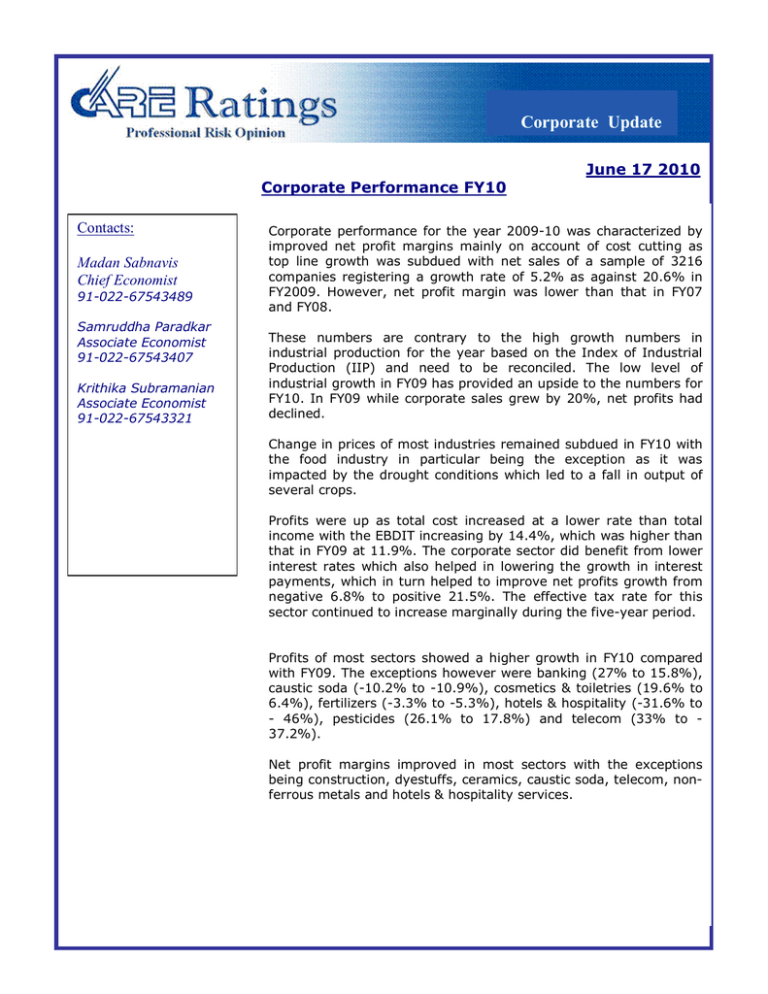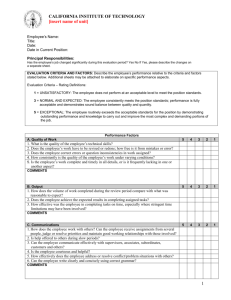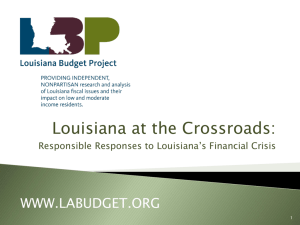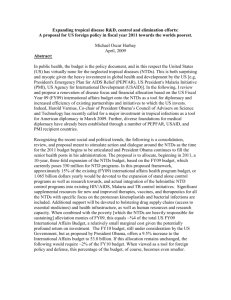Corporate Update June 17 2010 Corporate Performance FY10
advertisement

Corporate Update June 17 2010 Corporate Performance FY10 Contacts: Madan Sabnavis Chief Economist 91-022-67543489 Samruddha Paradkar Associate Economist 91-022-67543407 Krithika Subramanian Associate Economist 91-022-67543321 Corporate performance for the year 2009-10 was characterized by improved net profit margins mainly on account of cost cutting as top line growth was subdued with net sales of a sample of 3216 companies registering a growth rate of 5.2% as against 20.6% in FY2009. However, net profit margin was lower than that in FY07 and FY08. These numbers are contrary to the high growth numbers in industrial production for the year based on the Index of Industrial Production (IIP) and need to be reconciled. The low level of industrial growth in FY09 has provided an upside to the numbers for FY10. In FY09 while corporate sales grew by 20%, net profits had declined. Change in prices of most industries remained subdued in FY10 with the food industry in particular being the exception as it was impacted by the drought conditions which led to a fall in output of several crops. Profits were up as total cost increased at a lower rate than total income with the EBDIT increasing by 14.4%, which was higher than that in FY09 at 11.9%. The corporate sector did benefit from lower interest rates which also helped in lowering the growth in interest payments, which in turn helped to improve net profits growth from negative 6.8% to positive 21.5%. The effective tax rate for this sector continued to increase marginally during the five-year period. Profits of most sectors showed a higher growth in FY10 compared with FY09. The exceptions however were banking (27% to 15.8%), caustic soda (-10.2% to -10.9%), cosmetics & toiletries (19.6% to 6.4%), fertilizers (-3.3% to -5.3%), hotels & hospitality (-31.6% to - 46%), pesticides (26.1% to 17.8%) and telecom (33% to 37.2%). Net profit margins improved in most sectors with the exceptions being construction, dyestuffs, ceramics, caustic soda, telecom, nonferrous metals and hotels & hospitality services. CORPORATE UPDATE Sample Table 1: Financial Performance of Companies (FY06-FY10) Rs crore Financial Performance of 3,216 companies 2006 2007 2008 2009 Net Sales 16,14,249 20,63,600 24,91,532 30,05,437 Other income 73,524 99,692 1,19,161 1,31,063 Stocks 17,220 15,266 25,214 7,239 Total income 17,04,993 21,78,558 26,35,907 31,43,739 Raw materials 897,844 11,28,453 13,11,720 15,94,704 Salaries and wages 1,09,140 1,35,972 1,61,045 1,96,463 Other expenses 2,86,623 3,57,060 4,53,228 5,58,339 Total expenses 12,93,608 16,21,484 19,25,994 23,49,505 EBIDT 4,11,385 5,57,074 7,09,913 7,94,234 Interest 1,36,724 1,80,209 2,54,403 3,44,317 Depreciation 54,095 64,940 72,913 84,263 Provisions 68,996 94,851 114,527 115,753 Provision for taxes 50,353 75,858 95,398 88,805 Net profit 1,51,570 2,17,074 2,68,071 2,49,901 Source: Unaudited annual financial results from CMIE Prowess 2010 31,62,776 1,43,529 25,652 33,31,957 16,29,967 2,17,017 5,76,463 24,23,447 9,08,509 3,56,349 102,091 146,364 113,537 3,03,705 The sample chosen for this study comprises 3,216 companies in both the manufacturing and financial sectors classified under 40 industry groups and subgroups. Overall sales of the sample chosen was around Rs 31.6 lkh crore in 2009-10 (Table 1), which would be sized at around 50% of India’s GDP at current market prices. In terms of value added the sample accounts for around 18% of GDP. The manufacturing companies had a share of 85% in this selected sample of companies. Financial performance of companies Table 2 shows that for this set of companies, sales increased by 5.2% in FY10, which was the lowest in the last 4 years. Growth in sales had slowed down in FY08 and FY09 relative to FY07 when growth had peaked at 27.8%, but was still high at around 20%. Top line growth was however low and contrary to the picture presented by overall growth in the IIP which showed manufacturing sector growing by 10.9% in FY10 relative to 2.8% in FY09. There was a substantial increase in the build-up of stock in FY10 as they went back to the pre-FY09 levels. In FY09 stocks had declined by 71.3%. Growth in other income had tended to slow down in the last three years and was at the lowest of 9.5% in FY10. As a consequence of low growth in net sales and other income, total income increased by a modest 6% in FY10 as against 19.3% in FY09. Growth in total expenses had come down more than commensurately compared with sales and increased 3.1% caused by lower growth in raw materials (2.2% in FY10 as against 21.6% in FY09), salaries and wages (10.5% as against 22%) and other expenses (3.2% as against 23.2%). As total expenses grew at a slower rate than total income, EBDIT increased at a higher rate of 14.4% in FY10 compared with 2 CORPORATE UPDATE 11.9% in FY09. Cost cutting was hence the primary reason behind enhanced profit growth in FY10. A substantial decline in rate of growth of interest costs of just 3.5% as against 35.3% in FY09 was aided by lower interest rates (average PLR on a point to point basis had declined by 50 bps in the year). This helped to increase net profits by 21.5% as against a fall of 6.8% in absolute levels of net profit in FY09. This was contrary to the FY09 picture when interest costs had increased by 35.3% on top of growth of 31.8% and 41.2% in FY07 and FY09, resulting in a decline in net profits by 6.9%. It is significant to note that interest costs as a percent of net sales has showed an increasing trend for manufacturing companies and has risen from 1.75% in FY06 to 2.18% in FY10. This is reflective of higher investment taking place. Growth in interest payments for manufacturing companies was buoyant between FY07-FY09. Table 2: Growth in Corporate Financial indicators (%) 2007 27.8 35.6 -11.3 27.8 25.7 24.6 24.6 25.3 35.4 31.8 20.0 37.5 50.7 43.2 Net Sales Other income Stocks Total income Raw materials Salaries and wages Other expenses Total expenses EBIDT Interest Depreciation Provisions Provision for taxes Net profit 2008 20.7 19.5 65.2 21.0 16.2 18.4 26.9 18.8 27.4 41.2 12.3 20.7 25.8 23.5 2009 20.6 10.0 -71.3 19.3 21.6 22.0 23.2 22.0 11.9 35.3 15.6 1.1 -6.9 -6.8 2010 5.2 9.5 254.4 6.0 2.2 10.5 3.2 3.1 14.4 3.5 21.2 26.4 27.8 21.5 Reconciling with IIP numbers The manufacturing sector grew by 10.9% in FY10 aided by a low base as growth was just 2.8% in FY09. Table 3 below gives a ‘what if’ scenario for different growth scenarios in FY10 in case growth in FY09 was at 8, 7 and 6 % respectively. Growth in FY10 would have then been in the region of 5.5 to 7.5%. Quite clearly growth has been propped up by the low base year effect. Table 3: Simulating growth in FY10 based on “What if” FY09 Actual 2.8 Assuming growth in FY09 6.0 7.0 FY10 10.9 7.5 6.5 Source: CSO and CARE (for simulation) 8.0 5.5 3 CORPORATE UPDATE Ratio analysis Table 4 provides information on some important ratios on the performance of the sample companies in the last 5 years. a. Profit margins have shown a turnaround in FY10 after declining in FY09. Margins had been increasing between FY07 and FY08. This, as mentioned earlier was due to cost-cutting measures undertaken by the corporate sector. b. Interest cover defined as EBIT to interest payments has shown an improvement in FY10, though the ratio has been on the decline from FY06 onwards. a. However, if the finance companies are excluded, the interest cover for the manufacturing sector shows a different trend, increasing in FY07 to 8.78 and then declining to 8.43 and 5.11 in FY08 and FY09 respectively before rising again in FY10 to 6.43. c. The effective tax rate defined as tax provisions to profits before tax has shown an increasing trend and peaked in FY2010, notwithstanding the fiscal stimulus that was provided. Clearly, the benefits were on the indirect taxes and expenditure fronts and not on direct taxes for the corporates. d. The contribution of other income was constant over the years and did not add significantly to total revenue for the sector as a whole. e. In terms of share in total expenses, the ratio of salaries & wages increased marginally in FY10 to 9% while that of raw materials came down. Table 4: Important ratios (%) Net profit to sales EBIDT to Sales Interest cover (times) For manufacturing companies Effective tax rate Other income to total income Salaries & wages to total expenses Raw material to total expenses Other expenses to total expenses 2006 9.4 25.5 2.61 7.61 24.9 4.4 8.4 69.4 22.2 2007 10.5 27.0 2.73 8.78 25.9 4.6 8.4 69.6 22.0 2008 10.8 28.5 2.50 8.43 26.2 4.6 8.4 68.1 23.5 2009 8.3 26.4 2.06 5.11 26.2 4.2 8.4 67.9 23.8 2010 9.6 28.7 2.26 6.43 27.2 4.3 9.0 67.3 23.8 Sector-wise analysis Tables A. B. C. 5, 6 and 7 provide sector-wise details on three indicators: Growth in Net Sales Growth in Net Profits Net profit margins Table 5 shows that: o o Net sales for the sample were propped up by the finance sector, which otherwise on its own had registered a lower growth rate in FY10 relative to FY09. Within the manufacturing sector, the sectors that showed higher growth in net sales relative to the previous year were the auto segment (cars, CVs, 4 CORPORATE UPDATE o o two-wheelers, auto ancillaries), beverages, electronics, paints, gems and jewelry, cotton textiles and cement. Industries such as construction (affected by higher interest rates), ceramics, glass, food products (other than beverages), chemicals, petro-products, electricity, machinery, telecom, tyres and tubes, IT, hotels and hospitality and metals witnessed lower growth in FY10. o Construction sector was affected by the economic slowdown as well as more difficult conditions set by banks in lending to related sectors such as mortgages at the retail end. o Food precuts were affected by the drought as supplies of raw materials were stymied on account of low production. o Low agricultural production in turn had an impact on farm inputs such as fertilizers and pesticides. Another factor that may have affected some sectors is the low growth or decline in prices of manufactured products, as indicated by the Wholesale Price Index (WPI). o Prices had increased in case of food products, glass, chemicals (such as cosmetics, pesticides and drugs and pharma) etc. Net profits growth o o Profits of most of the sectors showed an increase in FY10 over FY09. (Table 6) o The exceptions were banking, caustic soda, cosmetics and toiletries, dyestuffs, fertilizers & hospitality (second successive year), pesticides, cotton textiles and telecom. Sustained growth in profits was witnessed in case of two wheelers, paints and food products. o In case of most of the industries it was a change from a negative or low growth in profits in FY09 to a positive/high growth rate in FY10. Net profit margin As a consequence of both the growth in sales and net profits, the overall profit margins showed an improvement almost across the board (Table 7). While there were a few industries which witnessed decreased profit margins in FY10, the significant ones which had sharp declines were - telecom - construction - caustic soda - non-electrical machinery - hotels and hospitality sectors. 5 CORPORATE UPDATE Table 5: Growth in Net Sales and Change in Prices based on WPI Growth in Net Sales (%) Change in WPI (%) 2007 2008 2009 2010 2009 2010 All 27.8 20.7 20.6 5.2 8.4 3.8 Finance 25.4 27.4 28.0 9.3 Manufacturing companies 28.2 19.8 19.5 4.6 8.1 3.2 Passenger cars 21.9 21.2 12.9 41.3 Two wheelers 15.0 0.5 6.1 22.5 2.5 4.9 Commercial Vehicles 32.0 5.2 -13.5 35.3 5.2 0.1 Auto Ancillary 24.3 13.2 5.4 10.5 14.9 2.9 Banking 24.2 31.1 29.4 8.7 Cement 58.8 19.5 15.3 17.9 2.7 -0.1 Construction 47.1 50.6 21.9 16.6 Ceramics 26.2 18.2 13.5 4.1 4.1 2.3 Glass 12.4 40.9 24.7 7.6 -0.9 10.0 Food Products 21.2 21.0 18.6 15.6 10.0 16.8 Vegetable oils 22.3 30.1 12.3 5.9 7.4 -5.9 Sugar 16.4 -5.9 22.3 14.7 12.4 45.3 Beverages, tobacco 26.1 17.7 15.0 17.7 9.5 5.1 Chemicals 23.2 17.4 25.4 -3.5 7.2 4.4 Caustic soda 15.0 15.0 26.2 -8.0 14.4 -2.6 Cosmetics, toiletries etc 13.0 14.5 38.1 -4.8 7.7 12.3 Drugs & Pharmaceuticals 23.8 21.7 12.6 10.1 1.9 19.5 Dyestuffs -2.2 24.2 12.3 2.2 6.7 -4.7 Fertilizers 12.9 13.6 70.3 -24.3 8.7 -2.5 Polymers 9.9 8.6 4.9 3.8 6.1 -6.8 Paints etc 17.5 15.2 14.5 16.8 10.4 4.8 Pesticides 10.8 23.4 34.0 5.3 5.0 18.6 Crude oil 16.8 6.5 11.7 -5.7 11.1 -4.8 Petro Products 25.1 17.2 24.6 -4.3 Electricity 20.7 20.8 17.9 7.4 1.1 0.7 Textiles 19.2 19.3 8.2 6.8 6.0 6.0 Synthetic textiles 22.5 21.5 8.0 4.1 2.9 -2.0 Cotton Textiles 14.1 17.7 7.8 18.9 7.8 8.4 Non-electrical machinery 31.8 18.1 17.2 4.4 5.2 0.9 Electrical machinery 41.8 34.7 12.9 6.4 4.2 -1.1 Electronics 23.1 3.8 13.3 16.0 -3.2 0.0 Telecommunication 86.6 27.3 21.8 2.3 Ferrous metals 27.5 23.2 15.2 3.3 1.4 -3.1 Steel 26.2 19.6 14.9 2.8 20.6 -13.6 Non-ferrous metals 60.5 2.2 -8.7 11.3 -6.5 -4.5 Tyres and tubes 26.2 12.4 22.6 6.4 6.7 6.0 Gems and Jewelry 29.5 28.3 21.6 34.4 Hotels, hospitality services 32.1 13.8 -8.5 -10.2 Information technology 43.4 24.7 22.7 7.4 Diversified 23.1 17.4 25.0 6.9 P.S: WPI prices are broadly indicative as the % change is for a closely-related group and may not perfectly match the industry concerned. Where such a match does not exist, the cells have been left blank. 6 CORPORATE UPDATE Table 6: Change in net profits: sector-wise All Finance Manufacturing companies Passenger cars Two wheelers Commercial Vehicles Auto Ancillary Banking Cement Construction Ceramics Glass Food Products Vegetable oils Sugar Beverages, tobacco Chemicals Caustic soda Cosmetics, toiletries etc Drugs & Pharmaceuticals Dyestuffs Fertilizers Polymers Paints etc Pesticides Crude oil Petro Products Electricity Textiles Synthetic textiles Cotton Textiles Non-electrical machinery Electrical machinery Electronics Telecommunication Ferrous metals Steel Non-ferrous metals Tyres and tubes Gems and Jewelry Hotels, hospitality services Information technology Diversified 2007 43.2 26.5 47.1 32.0 -26.6 22.6 42.5 24.5 228.2 88.1 11.3 -35.7 95.7 54.4 -13.3 58.0 47.3 135.1 13.7 50.1 -62.9 6.2 805.9 208.9 7.1 8.3 53.8 17.4 29.7 70.3 9.1 41.5 50.0 * 200.5 50.0 50.1 93.4 145.9 133.4 61.7 56.5 49.7 2008 23.5 35.9 21.1 8.4 8.2 4.6 5.0 33.1 29.8 89.9 -5.9 60.7 -17.1 60.9 -102.6 10.1 18.4 -35.9 11.0 23.6 323.2 30.9 58.3 -28.1 25.7 6.9 14.8 17.3 -10.6 28.4 -44.9 18.5 54.5 -11.1 36.4 31.0 24.0 -5.9 5.4 23.6 9.3 21.3 69.0 2009 -6.8 16.8 -12.2 -28.5 27.1 -45.9 -23.6 27.0 -17.2 -8.2 -57.3 -44.5 31.0 -22.0 * -2.8 -22.1 -10.2 19.6 -37.9 135.9 -3.3 -94.1 29.6 26.1 -3.1 -25.8 3.9 -59.8 -29.2 -125.1 -25.2 1.3 -47.2 33.3 -30.7 -28.1 -27.3 -55.9 -59.1 -31.6 5.4 -32.0 2010 21.5 17.6 22.7 121.5 76.6 107.9 40.2 15.8 18.0 9.4 -14.6 108.9 56.5 50.2 23.3 26.4 45.8 -10.9 6.4 64.0 -16.1 -5.3 * 46.1 17.8 3.8 54.0 12.5 173.4 61.9 * 3.1 38.6 23.7 -37.2 40.9 35.7 8.7 225.2 262.6 -46.0 22.7 18.6 *: net profit changes from negative to positive. 7 CORPORATE UPDATE Table 7: Net Profit Margin All Finance Manufacturing companies Passenger cars Two wheelers Commercial Vehicles Auto Ancillary Banking Cement Construction Ceramics Glass Food Products Vegetable oils Sugar Beverages, tobacco Chemicals Caustic soda Cosmetics, toiletries etc Drugs & Pharmaceuticals Dyestuffs Fertilizers Polymers Paints etc Pesticides Crude oil Petro Products Electricity Textiles Synthetic textiles Cotton Textiles Non-electrical machinery Electrical machinery Electronics Telecommunication Ferrous metals Steel Non-ferrous metals Tyres and tubes Gems and Jewelry Hotels, hospitality services Information technology Diversified 2006 9.4 14.0 8.7 9.7 9.5 6.9 7.1 12.6 8.6 8.7 6.2 9.6 3.3 1.7 9.8 14.5 4.7 13.5 13.9 13.8 3.5 6.2 0.5 5.4 7.7 37.7 3.5 22.9 6.5 6.7 5.5 11.4 5.7 -2.8 10.7 9.9 11.2 18.0 3.2 1.6 17.0 20.8 5.4 2007 10.5 14.1 10.0 10.5 6.0 6.4 8.2 12.7 17.8 11.2 5.5 5.5 5.3 2.1 7.3 18.2 5.6 27.6 14.0 16.7 1.3 5.9 4.4 14.1 7.4 35.0 4.3 22.2 7.0 9.3 5.3 12.3 6.1 6.5 17.2 11.6 13.3 21.7 6.2 3.0 20.8 22.7 6.6 2008 10.8 15.1 10.1 9.4 6.5 6.4 7.6 12.9 19.4 14.1 4.4 6.2 3.6 2.6 -0.2 17.0 5.7 15.4 13.5 17.0 4.6 6.8 6.4 8.8 7.5 35.1 4.2 21.6 5.3 9.9 2.5 12.3 7.0 5.6 18.4 12.3 13.8 19.9 5.8 2.8 19.9 22.1 9.5 2009 8.3 13.8 7.4 5.9 7.8 4.0 5.5 12.6 13.9 10.6 1.7 2.8 4.0 1.8 6.8 14.3 3.5 11.0 11.7 9.4 9.6 3.8 0.4 10.0 7.1 30.5 2.5 19.0 2.0 6.5 -0.6 7.9 6.2 2.6 20.2 7.4 8.6 15.9 2.1 1.0 14.9 19.0 5.2 2010 9.6 14.8 8.7 9.3 11.2 6.2 7.0 13.4 13.9 10.0 1.4 5.4 5.4 2.6 7.3 15.4 5.3 10.6 13.1 14.0 7.8 4.8 3.3 12.5 8.0 33.5 4.0 19.9 5.0 10.1 2.3 7.8 8.1 2.8 12.4 10.1 11.4 15.5 6.4 2.6 9.0 21.7 5.7 8 CORPORATE UPDATE This page has been left blank intentionally ---------------------------------------------------------------------------------------------Disclaimer The Report is prepared by the Economics Division of CARE Limited. The Report is meant for providing an analytical view on the subject and is not a recommendation made by CARE. The information is obtained from sources considered to be reliable and CARE does not guarantee the accuracy of such information and is not responsible for any decision taken based on this Report. 9





